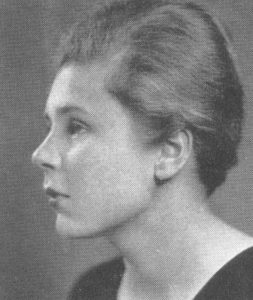
See image credit below.
For Patricia Dwyer, whose love of Elizabeth Bishop’s poetry inspires my own
Nova Scotia. Just the sound of those two words conjures up evocative images for me. I’ve never been there, but I have always wanted to go.
Maybe the fact that poet Elizabeth Bishop (1911-1979) spent some of her childhood there is part of what draws me to her and her poetry. After all, as so many critics and scholars have observed, Bishop was fairly obsessed with place, with geography. Indeed, one of her volumes of poetry was titled Questions of Travel, another Geography III.
Nova Scotia is one of those places that called to Bishop in her poetry – and her poem “The Moose,” set in the Canadian province, is my favorite of Bishop’s poems. I love how Bishop isolates a specific, transformative moment in time – a moose on the macadam in front of a Boston-bound bus late at night.
The poem opens with Bishop’s evocation of Nova Scotia:
From narrow provinces,
of fish and bread and tea,
home of the long tides
where the bay leaves the sea
twice a day and takes
the herrings long rides.
Bishop continues as she describes “red, gravelley roads,” “rows of sugar maples,” “clapboard farmhouses and neat, clapboard churches.”
Just as she brings Nova Scotia to life, she also captures the ordinariness of murmured conversation as the bus travels those red, gravelley roads. We hear the dailiness, the thinginess of human concerns – “what he said, what she said, who got pensioned.”
Then the moose, suddenly, swiftly, appears in the middle of the macadam road on a dark Nova Scotia night, brings the busload of people to a screeching halt. Contact between our lived lives and the nearly magical animal kingdom! Not magical in the sense of unicorns or other mythical creatures but magical in the sense that they coexist with us, live lives of majesty and beauty, power and terror parallel to our own. Bishop writes,
Taking her time,
she looks the bus over,
grand, otherworldly.
Why, why do we feel
(we all feel) this sweet
sensation of joy?“Curious creatures,”
says our quiet driver,
rolling his r’s.
“Look at that, would you.”
I know that sweet sensation of joy. I always marvel at seeing a deer on the urban street on which I live, and a couple of years ago, my husband and I were captivated (then irritated) by the mama raccoon and baby that made our window well their home. How, I wonder, do these wild creatures manage to survive – live their lives – in the midst of so much human encroachment?
Of course, Boulder, Colorado, in 2016 is a far cry from rural Nova Scotia in the 1910s. It was more likely that Nova Scotians would encounter wildlife, even moose. But, oh, how marvelous it is any time there is a cross-species meeting!
Curious about Bishop’s childhood home? It was for sale recently – at just under $100,000. It was purchased late last year by Nova Scotia visual artist Catherine MacLean. Previously, it was used as an artist’s retreat but has now been become once again a single-family home.
Bishop traveled all over the world and, in fact, spent a great deal of her time in Brazil. But for me, Nova Scotia is among her most powerful places. To learn more about Elizabeth Bishop and her connection to the Canadian province, visit the Elizabeth Bishop Society of Nova Scotia website. Other outstanding resources are the Elizabeth Bishop Centenary blog and the Elizabeth Bishop page on My Poetic Side, which features a great gallery of Bishop portraits.
If you want to read more of Bishop’s poetry, you’ll want to take a look at The Complete Poems: 1927-1979 as well as the Library of America volume Elizabeth Bishop: Poems, Prose, and Letters (Library of America)
. In addition, One Art
, a volume of Bishop’s letters, is indispensable reading for those who like to get the inside skinny on writers and their lives – and you’ll also love Lorrie Goldensohn’s outstanding book, Elizabeth Bishop: The Biography of a Poetry
.
Podcast: Play in new window | Download
Subscribe to StoryWeb in iTunes.Listen to the podcast in Stitcher.
Image Credit: Elizabeth Bishop’s photo from the 1934 Vassar College yearbook. Public domain. https://en.wikipedia.org/wiki/Elizabeth_Bishop#/media/File:Elizabeth_Bishop,_1934_yearbook_portrait.jpg.